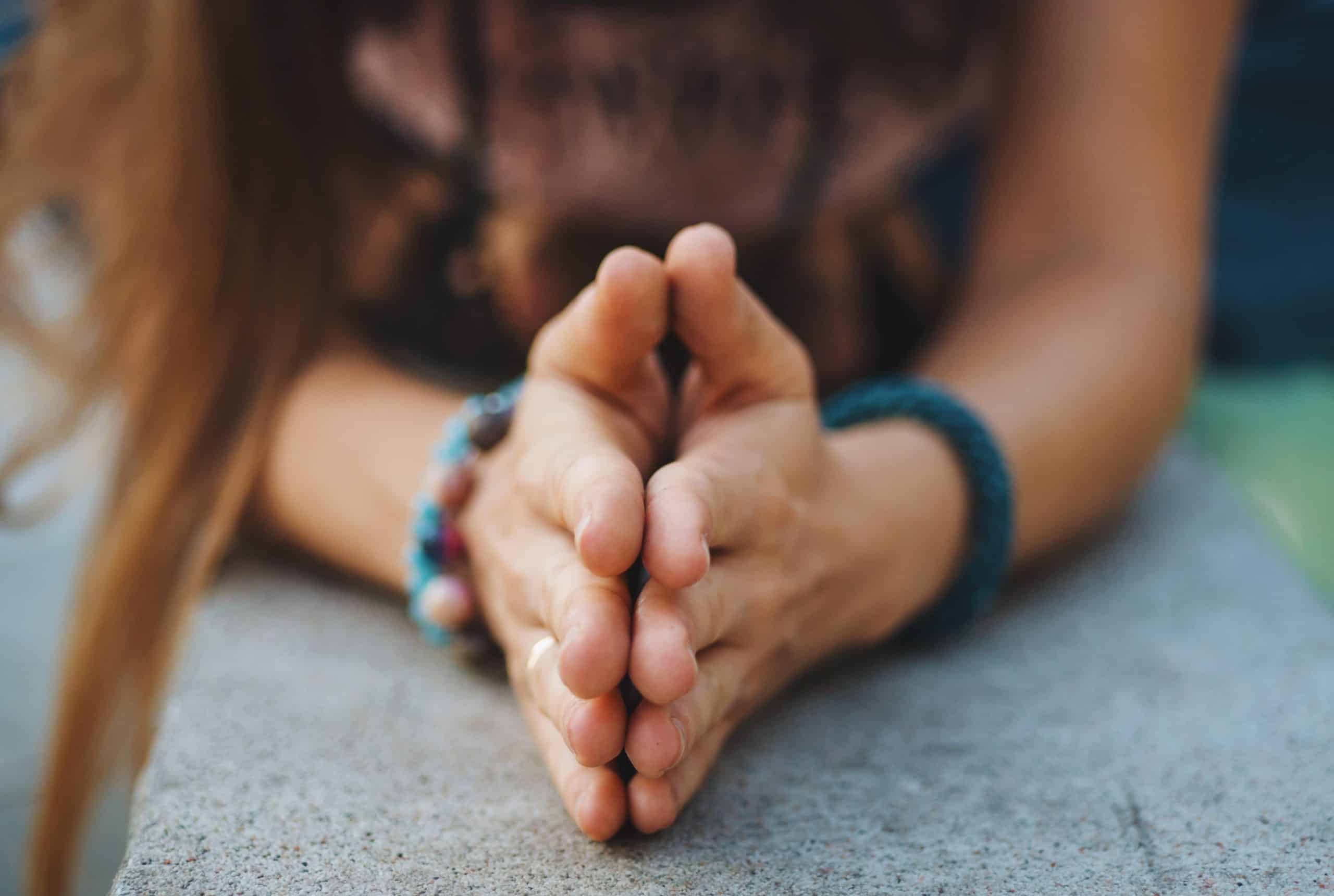A yoga instructor sits with the legs crossed in front of the class, presses hands together in a prayer position, and leans forward to pronounce one special word – “namaste”. Dutiful yoga practitioners mirror the pose, bow, and whisper “namaste” in unison. Sounds familiar? If you have done yoga online or offline you have stumbled upon yoga teachers who used this ancient word after each yoga class. This tradition has become so common that it is almost impossible to imagine yoga ending without pronouncing namaste. People have gotten used to using this term without a deep understanding of the term itself. Does namaste mean exactly what we thought? Should it be used in yoga at all? If yes, then what is the best response to it? Today in this article you are going to disclose the answers to essential questions. Yoga namaste – evoke the divine in you.
Get your personalized
meal plan!
What Does Namaste Mean?
Yoga is a combination of a total body workout and meditation that doesn’t only tone our body/mind and burn calories but also allows us to find inner power (3).
In addition, it improves sleep quality, inspires people to eat healthier food, reduces stress levels, and encourages people to exercise more (4).
And each yoga class ends in unison whispering “Namaste”.
But have you ever thought about the real meaning and usage of the word namaste, or just pronounced this word believing it meant something sacred?
People in the yoga community know one divine meaning of namaste – “The Divine in me honors the Divine in you”. Sounds sentimental but is that a real meaning? Let’s dig deeper into the origin.
‘Nama’ means bow; ‘as’ means I; and ‘te’ is you”. We can translate this word as “I bow to you”.
“The Divine in you” interpretation originated from the Hindu belief that God lived in everyone’s heart. However, it has nothing to do with religion. In yoga, people use it to demonstrate respect as a profound gesture to another person.
To conclude, yoga teachers use this term with their students to try to shed light on a more elevated part of themselves, referring to the inner light.
Read More: The Yoga Lifestyle: How To Find Balance In Your Life
What’s The Difference Between Namaskar And Namaste?
Namaste and namaskar refer to a similar expression of respect. Like namaste, namaskar is an Indian cultural way to greet people and show respect. When you pronounce namaskar or namaste you need to hold the palms upright in front of the chest.
Both of the words are derived from Sanskrit and play a big role in Indian culture and tradition. In most English dictionaries, these words are referred to as synonyms. The main question is: “Is there a difference between them?”.
Namaste and namaskar involve the Sanskrit root word “namah”, which means “bow.” As was mentioned above, namaste is the derivation of the words ‘namah’ and ‘te’ which mean “I salute or bow to you with respect.”
“Namaskar” is the combination of the words namah and kar. The word ‘kar’ means “to do.” Therefore, “namaskar” means, “I do the act of bowing with respect.”
In namaskar, the Supreme Consciousness resides within a person. When people say “namaskar” when greeting others, they are greeting a person but referring to the oneness within.
Namaste, on the contrary, is regarded to salute the divine deity. However, people use these two gestures of respect interchangeably. They see each other on the street, enter the shops and greet others by saying “namaste” and not namaskar.
In yoga traditions, namaste is used to acknowledge the divine within every individual instead of greeting others. But is it accurate to use namaste in yoga? Keep reading to find out.
Is It Ok To Say Namaste In Yoga?
Using namaste at the end of the yoga class may seem a little confusing to some South Asians. The point is that people from South Asian cultures use this word as a greeting of respect to elders, teachers, and other honorable people. For example, teenagers use it to greet the elderly and students greet their teachers.
People also use it in South Asia when they enter some facilities, like shops or hotels, as a greeting. That is why implementing namaste into yoga classes might sound too unnatural and duplicitous.
It is okay to use it in yoga class but not as a pseudo-spiritual way to indicate the end of the class but use it as a greeting. Thus, pronouncing the term at the beginning of the class seems to be more suitable. In this way, you will show respect to the rest of the members and your readiness to dive into the inner self.
Namaste can be also expressed to yourself as a way to fall into a soothing meditation. It aids in better concentration and resilience to outside sounds.
BetterMe app will provide you with a host of fat-frying fitness routines that’ll scare the extra pounds away and turn your body into a masterpiece! Get your life moving in the right direction with BetterMe!
How To End A Yoga Class Without Saying Namaste?
There are many other ways you can end your yoga class. Namaste is not an option since it is not used properly and in the right context.
Pay attention to your feelings first. If you are a yoga instructor or take a solo class online you can finish the yoga experience with your feelings. For example, instead of saying namaste you can press your hands together and bow, whispering something you have gained today: peace, happiness, or gratitude. You pronounce one word out loud as a sign of confirmation that you have received the knowledge.
Other people prefer expressing their feelings with the phrase “I feel….” at the end of the yoga session.
I feel relieved, I feel inspired, I feel calm, I feel bored… – don’t hesitate to demonstrate your true ardor.
The problem with namaste is that people who don’t belong to South Asian culture or know very little about it have no connection to this word. Therefore, it is logical to speak your native language at the beginning or at the end of the class.
When you use the language you speak you will automatically get a better perception of what you are doing.
Opt for the relaxing affirmation or only one word that resonates with your mood and feelings.
What Is Hot Namaste Yoga?
When people get deeper into the namaste yoga notion they discover other engaging branches: namaste fitness and hot namaste yoga. Regular yoga can promote mindful eating which is vital to overweight people or those who can’t help fishing out chips from the drawer at night (2).
Then imagine what hot namaste yoga does to you! Let’s start with the notion itself.
Hot namaste yoga is a 60, 75, or 90-minute class of regular yoga practiced in a room heated to approximately 105 F and about 40% of humidity. In other words, it is regarded as “burning” or “hellish” yoga.
This yoga focuses on much slower poses with fewer transitions. This practice remains consistent in each class which allows you to work in your body instead of switching various poses. Hot namaste yoga helps you meditate inward from the beginning of the class and relax completely at the end of the practice.
This is a tougher version of yoga for the higher temperature. That is why people with poor health conditions should consult a doctor before engaging in this kind of yoga.
If you decide to start a hot namaste yoga you need to stay hydrated. The protective hydration behavior depends on the encouragement of your instructor (1).
Read More: Yoga For Weight Lifters: Why You Need To Add It To Your Routine
The Bottom Line
Yoga namaste – evoke the divine in you – this can be considered as the leading purpose of namaste yoga. Namaste is a regular part of yoga that ends sessions with a pronounced namaste word and two hands pressed against each other. This is the way to show the acknowledgment of the divine entity within every human being.
However, the original meaning of namaste interferes with its usage in yoga practices. People from South Asian cultures use namaste as a greeting and respect towards honorable people.
That is why ending the class with namaste is a tad confusing. There are other good ways to end a yoga class without namaste by using various affirmations or single revelation words in your native language.
Another type of namaste yoga is hot namaste yoga which is practiced at higher temperatures. It requires more hydration and stamina. People are advised to talk to their doctor especially when they aspire to start hot yoga namaste classes.
DISCLAIMER:
This article is intended for general informational purposes only and does not serve to address individual circumstances. It is not a substitute for professional advice or help and should not be relied on for making any kind of decision-making. Any action taken as a direct or indirect result of the information in this article is entirely at your own risk and is your sole responsibility.
BetterMe, its content staff, and its medical advisors accept no responsibility for inaccuracies, errors, misstatements, inconsistencies, or omissions and specifically disclaim any liability, loss or risk, personal, professional or otherwise, which may be incurred as a consequence, directly or indirectly, of the use and/or application of any content.
You should always seek the advice of your physician or other qualified health provider with any questions you may have regarding a medical condition or your specific situation. Never disregard professional medical advice or delay seeking it because of BetterMe content. If you suspect or think you may have a medical emergency, call your doctor.
SOURCES:
- Hydration and Hot Yoga: Encouragement, Behaviors, and Outcomes (2017, ncbi.nlm.nih.gov)
- Regular Yoga Practice Is Associated With Mindful Eating (2009, sciencedaily.com)
- Yoga (2021, webmd.com)
- Yoga and Wellness (2022, nccih.nih.gov)











